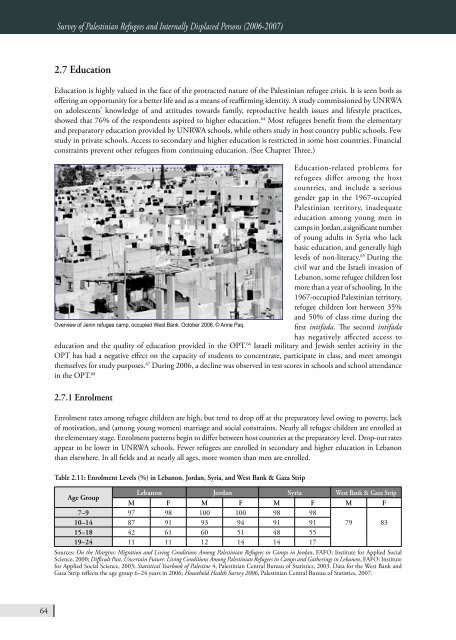BADIL Resource Center for Palestinian Residency and Refugee
BADIL Resource Center for Palestinian Residency and Refugee
BADIL Resource Center for Palestinian Residency and Refugee
You also want an ePaper? Increase the reach of your titles
YUMPU automatically turns print PDFs into web optimized ePapers that Google loves.
64<br />
Survey of <strong>Palestinian</strong> <strong>Refugee</strong>s <strong>and</strong> Internally Displaced Persons (2006-2007)<br />
2.7 Education<br />
Education is highly valued in the face of the protracted nature of the <strong>Palestinian</strong> refugee crisis. It is seen both as<br />
offering an opportunity <strong>for</strong> a better life <strong>and</strong> as a means of reaffirming identity. A study commissioned by UNRWA<br />
on adolescents’ knowledge of <strong>and</strong> attitudes towards family, reproductive health issues <strong>and</strong> lifestyle practices,<br />
showed that 76% of the respondents aspired to higher education. 64 Most refugees benefit from the elementary<br />
<strong>and</strong> preparatory education provided by UNRWA schools, while others study in host country public schools. Few<br />
study in private schools. Access to secondary <strong>and</strong> higher education is restricted in some host countries. Financial<br />
constraints prevent other refugees from continuing education. (See Chapter Three.)<br />
Education-related problems <strong>for</strong><br />
refugees differ among the host<br />
countries, <strong>and</strong> include a serious<br />
gender gap in the 1967-occupied<br />
<strong>Palestinian</strong> territory, inadequate<br />
education among young men in<br />
camps in Jordan, a significant number<br />
of young adults in Syria who lack<br />
basic education, <strong>and</strong> generally high<br />
levels of non-literacy. 65 During the<br />
civil war <strong>and</strong> the Israeli invasion of<br />
Lebanon, some refugee children lost<br />
more than a year of schooling. In the<br />
1967-occupied <strong>Palestinian</strong> territory,<br />
refugee children lost between 35%<br />
<strong>and</strong> 50% of class time during the<br />
first intifada. The second intifada<br />
has negatively affected access to<br />
education <strong>and</strong> the quality of education provided in the OPT. 66 Israeli military <strong>and</strong> Jewish settler activity in the<br />
OPT has had a negative effect on the capacity of students to concentrate, participate in class, <strong>and</strong> meet amongst<br />
themselves <strong>for</strong> study purposes. 67 During 2006, a decline was observed in test scores in schools <strong>and</strong> school attendance<br />
in the OPT. 68<br />
Overview of Jenin refugee camp, occupied West Bank. October 2006. © Anne Paq.<br />
2.7.1 Enrolment<br />
Enrolment rates among refugee children are high, but tend to drop off at the preparatory level owing to poverty, lack<br />
of motivation, <strong>and</strong> (among young women) marriage <strong>and</strong> social constraints. Nearly all refugee children are enrolled at<br />
the elementary stage. Enrolment patterns begin to differ between host countries at the preparatory level. Drop-out rates<br />
appear to be lower in UNRWA schools. Fewer refugees are enrolled in secondary <strong>and</strong> higher education in Lebanon<br />
than elsewhere. In all fields <strong>and</strong> at nearly all ages, more women than men are enrolled.<br />
Table 2.11: Enrolment Levels (%) in Lebanon, Jordan, Syria, <strong>and</strong> West Bank & Gaza Strip<br />
Age Group<br />
Lebanon<br />
M F M<br />
Jordan<br />
F M<br />
Syria<br />
F<br />
West Bank & Gaza Strip<br />
M F<br />
7–9 97 98 100 100 98 98<br />
10–14 87 91 93 94 91 91 79 83<br />
15–18 42 61 60 51 48 55<br />
19–24 11 11 12 14 14 17<br />
Sources: On the Margins: Migration <strong>and</strong> Living Conditions Among <strong>Palestinian</strong> <strong>Refugee</strong>s in Camps in Jordan, FAFO: Institute <strong>for</strong> Applied Social<br />
Science, 2000; Difficult Past, Uncertain Future: Living Conditions Among <strong>Palestinian</strong> <strong>Refugee</strong>s in Camps <strong>and</strong> Gatherings in Lebanon, FAFO: Institute<br />
<strong>for</strong> Applied Social Science, 2003; Statistical Yearbook of Palestine 4, <strong>Palestinian</strong> Central Bureau of Statistics, 2003. Data <strong>for</strong> the West Bank <strong>and</strong><br />
Gaza Strip reflects the age group 6–24 years in 2006; Household Health Survey 2006, <strong>Palestinian</strong> Central Bureau of Statistics, 2007.

















